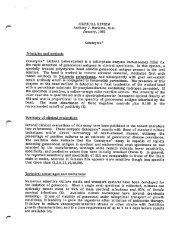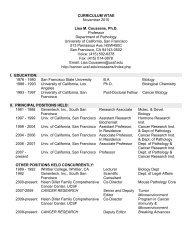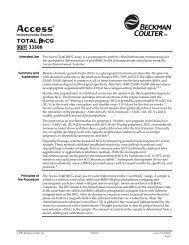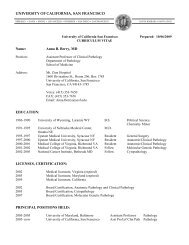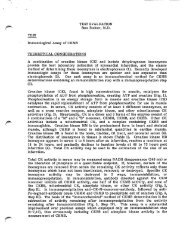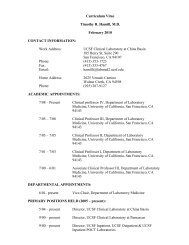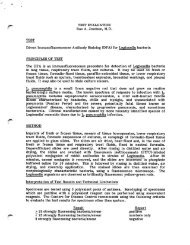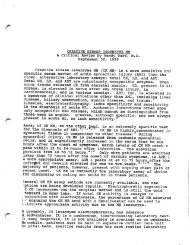Treatment Induced Changes in the Breast: Diagnosis and Staging of ...
Treatment Induced Changes in the Breast: Diagnosis and Staging of ...
Treatment Induced Changes in the Breast: Diagnosis and Staging of ...
You also want an ePaper? Increase the reach of your titles
YUMPU automatically turns print PDFs into web optimized ePapers that Google loves.
trials demonstrat<strong>in</strong>g similar overall survival <strong>in</strong> early stage patients treated by lumpectomy plus radiation<br />
versus mastectomy. The role <strong>of</strong> radiation <strong>in</strong> BCT is to improve local-regional control (reduce localregional<br />
recurrence).<br />
Recurrence follow<strong>in</strong>g BCT ranges from 5% to 22%. Most recurrences are detected with<strong>in</strong> 2 years by post<br />
treatment surveillance mammography, however, a number <strong>of</strong> o<strong>the</strong>r etiologies can produce abnormal<br />
mammograms or palpable lumps post-treatment. Approximately 10% <strong>of</strong> BCT patients will develop a new<br />
mass, new calcifications, or an abnormal mammogram that requires biopsy. About half <strong>of</strong> <strong>the</strong>se lesions<br />
are recurrent tumor; <strong>the</strong> o<strong>the</strong>r half are benign f<strong>in</strong>d<strong>in</strong>gs <strong>in</strong>clud<strong>in</strong>g fat necrosis or scar. Any <strong>of</strong> <strong>the</strong>se<br />
biopsies may harbor radiation <strong>in</strong>duced changes <strong>in</strong> <strong>the</strong> breast epi<strong>the</strong>lium, regardless <strong>of</strong> benign or<br />
malignant status. These radiation-<strong>in</strong>duced changes can be mis<strong>in</strong>terpreted as atypia or malignancy.<br />
Dist<strong>in</strong>guish<strong>in</strong>g benign lesions from recurrent tumor <strong>in</strong> <strong>the</strong> sett<strong>in</strong>g <strong>of</strong> radiation effect may be challeng<strong>in</strong>g –<br />
or impossible <strong>in</strong> rare cases—but a few features help guide <strong>the</strong> dist<strong>in</strong>ction.<br />
Radiation-<strong>in</strong>duced changes <strong>in</strong> benign breast<br />
Both <strong>the</strong> architecture (term<strong>in</strong>al duct-lobular unit, TDLU) <strong>and</strong> <strong>the</strong> cytology <strong>of</strong> <strong>the</strong> normal breast can be<br />
altered by radiation. The predom<strong>in</strong>ant changes occur at <strong>the</strong> level <strong>of</strong> <strong>the</strong> TDLU. Most notable at low<br />
power is an atrophic appearance <strong>of</strong> <strong>the</strong> TDLU. The basement membrane surround<strong>in</strong>g <strong>the</strong> ac<strong>in</strong>i is<br />
thickened <strong>and</strong> hyal<strong>in</strong>ized/collagenized as is <strong>the</strong> <strong>in</strong>tralobular stroma. The ac<strong>in</strong>ar epi<strong>the</strong>lium appears<br />
atrophic; <strong>the</strong> cells are fewer <strong>in</strong> number per ac<strong>in</strong>i <strong>and</strong> smaller <strong>in</strong> size. These features resemble postmenopausal<br />
lobular atrophy. At high power, cytologic atypia can be seen <strong>in</strong> <strong>the</strong> ac<strong>in</strong>ar epi<strong>the</strong>lium:<br />
enlarged hyperchromatic nuclei, small nucleoli, eos<strong>in</strong>ophilic cytoplasm, or f<strong>in</strong>ely vacuolated cytoplasm.<br />
Atypia can also affect <strong>the</strong> larger ducts. Importantly, <strong>the</strong> cytologic atypia is not accompanied by any<br />
evidence <strong>of</strong> loss <strong>of</strong> polarity, proliferation, mitoses or necrosis. In addition to epi<strong>the</strong>lial changes, <strong>the</strong><br />
myoepi<strong>the</strong>lial layer may become quite pronounced, with clear cytoplasm. Stromal changes may be<br />
appreciated. Nuclear enlargement, nuclear atypia, stellate or irregular nuclear contours <strong>and</strong> prom<strong>in</strong>ent<br />
nucleoli, can be seen <strong>in</strong> stromal fibroblasts. Vascular changes are not common; <strong>in</strong> Schnitt’s study only<br />
one quarter <strong>of</strong> specimens were affected. They noted vascular f<strong>in</strong>d<strong>in</strong>gs <strong>of</strong> myo<strong>in</strong>timal proliferation, mural<br />
hyal<strong>in</strong>ization <strong>and</strong> prom<strong>in</strong>ent capillary endo<strong>the</strong>lial cells.<br />
Architectural changes <strong>in</strong> TDLU<br />
-atrophic TDLU (small size, fewer ac<strong>in</strong>ar epi<strong>the</strong>lium)<br />
-thick, hyal<strong>in</strong>ized TDLU basement membrane<br />
-hyal<strong>in</strong>ized <strong>in</strong>tralobular stroma<br />
Cytologic changes <strong>in</strong> TDLU<br />
-enlarged hyperchromatic nuclei<br />
-prom<strong>in</strong>ent nucleoli<br />
-eos<strong>in</strong>ophilic cytoplasm<br />
-f<strong>in</strong>ely vacuolated cytoplasm<br />
-prom<strong>in</strong>ent myoepi<strong>the</strong>lium (abundant clear cytoplasm)<br />
This constellation <strong>of</strong> changes does not equally affect all radiated patients; <strong>in</strong> Schnitt et al’s study, about<br />
30% <strong>of</strong> patients showed mild changes <strong>and</strong> <strong>the</strong> rema<strong>in</strong>der showed more strik<strong>in</strong>g changes. The extent <strong>and</strong><br />
degree <strong>of</strong> changes can be variable with<strong>in</strong> a given specimen. For example, some TDLU could harbor only<br />
a few atypical cells while o<strong>the</strong>rs may be completely <strong>in</strong>volved by atypia. F<strong>in</strong>ally, <strong>the</strong> extent/degree <strong>of</strong><br />
changes do not appear related to <strong>the</strong> radiation dosage. More severe stromal changes such as fat<br />
necrosis <strong>and</strong> stromal fibroblast atypia may focally occur <strong>in</strong> <strong>the</strong> vic<strong>in</strong>ity <strong>of</strong> tissue targeted for external boost<br />
doses.<br />
Duration <strong>of</strong> changes follow<strong>in</strong>g radiation<br />
Radiation <strong>in</strong>duced changes do not appear to regress over time. Moore et al studied 117 patients who had<br />
undergone radiation <strong>the</strong>rapy <strong>and</strong> subsequent breast biopsy/excision up to 229 months later. The degree





